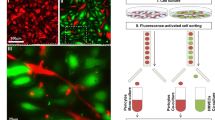Abstract
The microvascular pericyte is an important regulatory cell that maintains tissue homeostasis. One of the mechanisms by which pericytes maintain tissue homeostasis is through the induction of endogenous adaptative changes to stress signals. These adaptations include migration, differentiation and induction of angiogenesis. We have investigated pericyte responses to hypoxic stress (1 % O2) and have reported that pericytes adapt to hypoxia, in part, through changes in endogenous and released microRNAs (miRNAs). Of those miRNAs, Let-7d plays an important role. We exposed pericytes to hypoxia with and without basic fibroblast growth factor (bFGF) in stem cell medium. The expression of Let-7d in pericyte-derived neurospheres was determined. Evidence of differentiation was determined by immunocytochemistry. Hypoxia enhanced pericyte spheres were positive for Let-7d. The transcription factor Sox2, a marker of cell differentiation, was also induced in pericytic spheres. Taken together, our results suggest that pericyte expression of Let-7d in response to hypoxia and bFGF is involved in pericyte differentiation. Thus, for the first time, we propose a pathway for induction of pericyte differentiation. Modulation of this pathway in pericytes may be an important target in tissue repair.
Access this chapter
Tax calculation will be finalised at checkout
Purchases are for personal use only
Similar content being viewed by others
References
Lee RC, Feinbaum RL, Ambros V (1993) The C. elegans heterochronic gene lin-4 encodes small RNAs with antisense complementarity to lin-14. Cell 75(5):843–854
Bussing I, Slack FJ, Grosshans H (2008) let-7 microRNAs in development, stem cells and cancer. Trends Mol Med 14(9):400–409
Jovanovic M, Hengartner MO (2006) miRNAs and apoptosis: RNAs to die for. Oncogene 25(46):6176–6187
Schickel R, Boyerinas B, Park SM et al (2008) MicroRNAs: key players in the immune system, differentiation, tumorigenesis and cell death. Oncogene 27(45):5959–5974
Stefani G, Slack FJ (2008) Small non-coding RNAs in animal development. Nat Rev Mol Cell Biol 9(3):219–230
Boyerinas B, Park SM, Hau A et al (2010) The role of let-7 in cell differentiation and cancer. Endocr Relat Cancer 17(1):F19–F36
Pasquinelli AE, Reinhart BJ, Slack F et al (2000) Conservation of the sequence and temporal expression of let-7 heterochronic regulatory RNA. Nature 408(6808):86–89
Reinhart BJ, Slack FJ, Basson M et al (2000) The 21-nucleotide let-7 RNA regulates developmental timing in Caenorhabditis elegans. Nature 403(6772):901–906
Roush S, Slack FJ (2008) The let-7 family of microRNAs. Trends Cell Biol 18(10):505–516
Dore-Duffy P (2008) Pericytes: pluripotent cells of the blood brain barrier. Curr Pharm Des 14(16):1581–1593
Dore-Duffy P, Katychev A, Wang X et al (2006) CNS microvascular pericytes exhibit multipotential stem cell activity. J Cereb Blood Flow Metab 26(5):613–624
Dore-Duffy P, Mehedi A, Wang X et al (2011) Immortalized CNS pericytes are quiescent smooth muscle actin-negative and pluripotent. Microvasc Res 82(1):18–27
Dore-Duffy P, LaManna JC (2007) Physiologic angiodynamics in the brain. Antioxid Redox Signal 9(9):1363–1371
LaManna JC (1992) Rat brain adaptation to chronic hypobaric hypoxia. Adv Exp Med Biol 317:107–114
LaManna JC, Chavez JC, Pichiule P (2004) Structural and functional adaptation to hypoxia in the rat brain. J Exp Biol 207(Pt 18):3163–3169
Truettner JS, Katyshev V, Esen-Bilgin N et al (2013) Hypoxia alters MicroRNA expression in rat cortical pericytes. Microrna 2(1):32–44
Dore-Duffy P (2003) Isolation and characterization of cerebral microvascular pericytes. Methods Mol Med 893:75–82
Acknowledgments
We wish to thank the Eugene Applebaum Foundation, and Wayne State University for funding used to conduct these studies.
Author information
Authors and Affiliations
Corresponding author
Editor information
Editors and Affiliations
Rights and permissions
Copyright information
© 2016 Springer International Publishing Switzerland
About this paper
Cite this paper
Esen, N., Vejalla, A., Sharma, R., Treuttner, J.S., Dore-Duffy, P. (2016). Hypoxia-Induced Let-7d Has a Role in Pericyte Differentiation. In: Luo, Q., Li, L., Harrison, D., Shi, H., Bruley, D. (eds) Oxygen Transport to Tissue XXXVIII. Advances in Experimental Medicine and Biology, vol 923. Springer, Cham. https://doi.org/10.1007/978-3-319-38810-6_5
Download citation
DOI: https://doi.org/10.1007/978-3-319-38810-6_5
Published:
Publisher Name: Springer, Cham
Print ISBN: 978-3-319-38808-3
Online ISBN: 978-3-319-38810-6
eBook Packages: Biomedical and Life SciencesBiomedical and Life Sciences (R0)




